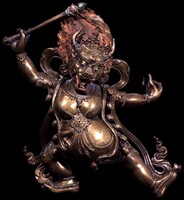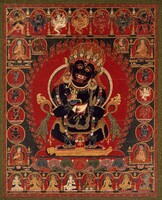Refuge Fields of the Bon Religion

Field of Accumulation, or Refuge Field: A Refuge Field is a particular type of iconographic composition that arranges all of the teachers and deities of a particular religious tradition (Tibetan Buddhist or Bon Religion) in one painted composition as formulated by individual religious traditions and as described in liturgical texts. The function of a Refuge Field is to be a visual composition reminding the devotee of all of the most sacred objects contained in the tradition, and in this case the Lama, Sanggye, Bon, Sempa, Yidam, Khandro and Sungma.
Based solely on observation there appears to be two types of Bon Refuge Field Paintings easily distinguishable by the iconography of the central figures. The first type depicts the figure of (1) Nyamme Sherab Gyaltsen. He is shown in his typical iconographic form wearing monastic robes and a lotus hat, holding flower blossoms supporting a sword and book. The second type of Refuge Field painting depicts the deity (2) Shenlha Okar, white in colour, seated in a posture of meditation with the hands placed in the lap. It is commonly said that the Shenlha Okar type was designed by Shardza Tashi Gyaltsen (1859-1933).
The oldest of the Bon Refuge Field paintings catalogued on the HAR site is #98896 belonging to the Hahn Collection. Unfortunately we do not have permission as yet to display the images from that collection. However, the painting is likely to be dated as early to mid 19th century and from Central Tibet. Many of the other Refuge Field paintings are of late 19th or 20th century creation and from Eastern Tibet.
Shenlha Okar Type: HAR #81494, 99000, 200013, 200016.
Nyamme Sherab Gyaltsen Type: HAR #64402, 70112, 70142, 98896.
















